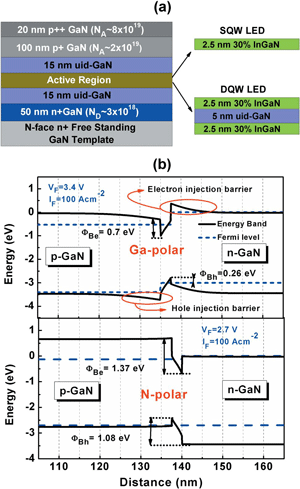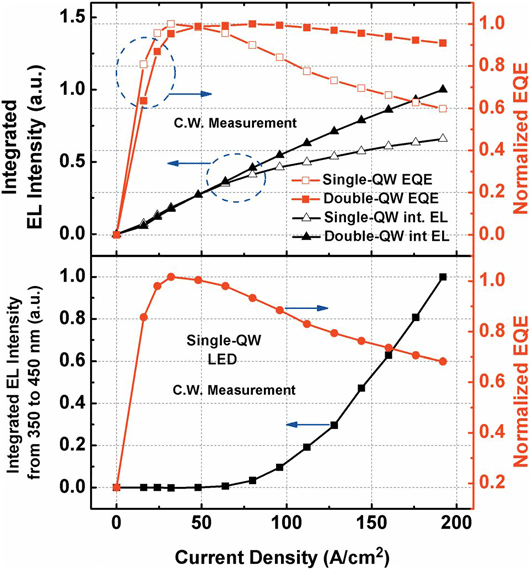- News
30 March 2012
Reversing polarization to tackle overshoot and droop
Ohio State University has suppressed overflow and droop effects in nitride semiconductor LEDs by reversing the polarization of the material [F. Akyol et al, Appl. Phys. Lett., vol100, p111118, 2012].
Usually nitride semiconductor LEDs are grown in the c-direction (0001) on Ga-face gallium nitride templates, which leads to strong polarization fields that affect LED performance. One effect is that the more mobile and plentiful electrons tend to overshoot the active region where light-emitting electron-hole recombination is desired. Such overflow reduces the luminous efficiency of the device.
The overshooting can be reduced by including aluminium gallium nitride (AlGaN) electron-blocking layer (EBLs). However, such layers also reduce hole injection into the active region, impacting efficiency adversely.
Simulations have suggested that devices grown on material where the polarization is reversed could benefit from improved performance. However, experimental reports have been few because such growth and/or substrates are not as mature as those obtained by more traditional methods.
 The new Ohio devices used free-standing N-face silicon-doped GaN substrates supplied by Lumilog. LEDs with single quantum wells (SQW) and double quantum wells (DQW) were produced (Figure 1). The semiconductor material growth was carried out using a Veeco Gen 930 nitrogen-plasma-assisted molecular beam epitaxy (MBE) system. The quantum-well growth temperature was 570°C. There was no electron-blocking layer.
The new Ohio devices used free-standing N-face silicon-doped GaN substrates supplied by Lumilog. LEDs with single quantum wells (SQW) and double quantum wells (DQW) were produced (Figure 1). The semiconductor material growth was carried out using a Veeco Gen 930 nitrogen-plasma-assisted molecular beam epitaxy (MBE) system. The quantum-well growth temperature was 570°C. There was no electron-blocking layer.
Figure 1: (a) Epitaxial structure of the SQW and DQW LEDs. (b) Simulated energy-band diagrams of Ga- and N-polar SQW LEDs at 100A/cm2 current density.
The p-electrode of the LED devices consisted of semi-transparent nickel/gold (4nm/6nm). The material was then etched to provide mesa isolation to create 250μm x 250μm devices. The n-contact consisted of titanium/gold (20nm/300nm). The p-contact pad/current spreader consisted of thick gold. Electrical and light-emission measurements were performed on-wafer, without dicing or packaging.
The devices had a low turn-on voltage of ~2.3V, attributed to “decreased electron and hole potential barriers in N-polar devices”, as expected from Ohio’s previous simulations. The SQW device showed higher leakage under reverse bias, which may be due to increased inter-band tunneling of electrons and holes across the thin N-polar active region.
The spectral position of the emission peaks blue-shifted with increasing current (16A/cm2 to 192A/cm2): from 558nm to 535nm for the SQW LED and from 565nm to 535nm for the DQW LED. The shift is attributed to polarization screening at low currents and band-filling at higher currents. The full-width at half maxima (FWHM) for the green peaks were 78nm and 67nm for the SQW and DQW devices, respectively.
The SQW LED also had an ultraviolet peak around 385nm when the current density exceeded 50A/cm2. By contrast, the DQW was without such a peak up to 400A/cm2. Such a peak can be attributed to electron overflow into the p-GaN layer.
The researchers comment: “Thus, it could be concluded that, while one quantum well with the given thickness may be insufficient to prevent electron overflow, the insertion of a second quantum well provides an efficient built-in potential barrier to electron overflow in our N-polar device”.
External quantum efficiency (EQE) measurements (Figure 2a) indicated conventional droop effects in the SQW device with a peak at a current density of 30A/cm2. The DQW had a much improved droop character with the peak occurring at 96A/cm2 and a small drop of 7% from this at 192A/cm2. The researchers also compared the onset of droop with the rise of the UV parasitic peak (Figure 2b).

Figure 2: (a) Integrated EL intensity and normalized EQE variation of SQW and DQW LEDs with continuous wave (CW) forward current. (b) Integrated UV-blue (350–450nm) EL intensity and normalized EQE as a function of CW current density.
The DQW LED was also tested under pulsed currents. The device then showed almost no efficiency droop. Pulsed currents are used to avoid self-heating effects that also degrade LED performance.
The researchers comment: “We have thus not only established the direct correlation between electron overflow and efficiency droop but also demonstrated how to overcome it by using DQW in N-face orientation”.
The devices were not optimized, so the absolute performance fell below that of state-of-the-art devices.
LED droop LEDs GaN substrates AlGaN EBLs MBE
The author Mike Cooke is a freelance technology journalist who has worked in the semiconductor and advanced technology sectors since 1997.
